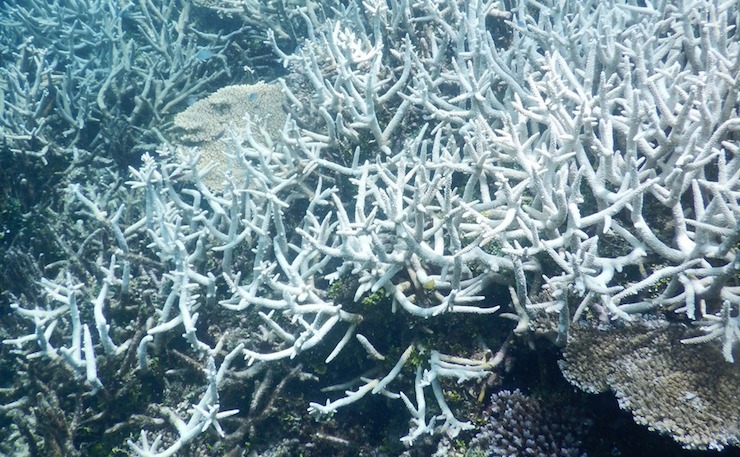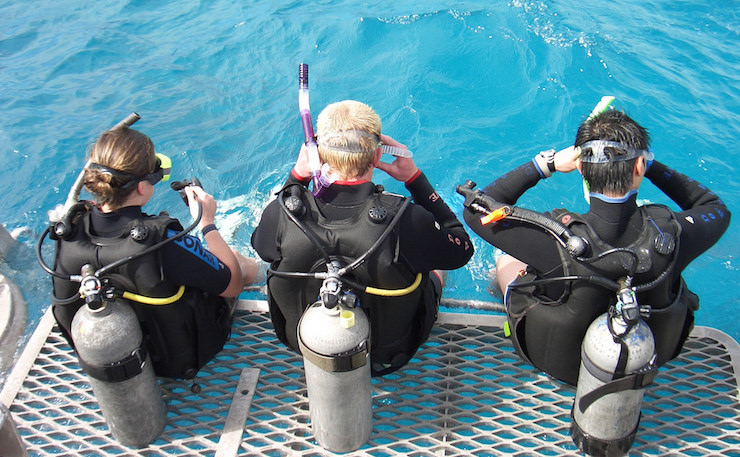ANALYSIS: New data showing the extent of coral bleaching reveals time is running out for one of Australia’s greatest natural resources. We can keep selling fossil fuels or we can have renewable jobs on the reef, but not both, writes Ben Eltham.
An unnatural disaster is unfolding in the waters of northern Queensland. The Great Barrier Reef is dying.
That’s the inescapable conclusion from the devastating reports of coral bleaching from the northernmost parts of the reef in recent days.
Led by Professor Terry Hughes of the ARC Centre for Excellence in Coral Reef Studies, the National Coral Bleaching Taskforce has just carried out an aerial survey of the northern stretch of the Barrier Reef. It’s horrifying.
Day 4, 3200km and 520 reefs – Solid evidence that #climatechange is destroying the #GreatBarrierReef. pic.twitter.com/cm594NNTxU
— Terry Hughes (@ProfTerryHughes) March 25, 2016
What Hughes found was shocking. The scale of the destruction is almost inconceivable. About 95 per cent of the reefs surveyed by Hughes and his colleagues were bleached. Even the healthiest corals were affected. The bleaching ran for a mind-boggling 4,000 kilometres.
“This has been the saddest research trip of my life,” Hughes said in a media statement today. “Almost without exception, every reef we flew across showed consistently high levels of bleaching, from the reef slope right up onto the top of the reef.”
“We flew for 4000 kilometres in the most pristine parts of the Great Barrier Reef and saw only four reefs that had no bleaching,” Hughes said. “The severity is much greater than in earlier bleaching events in 2002 or 1998.”
“We could see extensive bleaching even among the most robust ‘massive’ corals,” added James Kerry, a project manager in the Bleaching Taskforce who also participated in the aerial surveys. “The fact that these hardy species have also turned white shows just how severe summer conditions have become on the northern Great Barrier Reef.”
Kerry noted that “residents we spoke to in Cape York were shocked by what they are seeing, telling us that they had never experienced anything like this before.”
It’s difficult to over-estimate just how bad this year’s bleaching event is. This is an environmental and economic tragedy on a grand scale.
Coral bleaching is a relatively new phenomenon on historical timelines. Coral core samples stretching back 400 years show that it was practically unknown before the late 1970s. The first serious “global bleaching” event occurred in 1998, during the particularly intense El Nino of that year. There was another event in 2002. But this year’s bleach looks to be the worst ever.
Coral bleaching is caused by unusually warm ocean temperatures, which can kill the algae that live in coral limestone. It can take a reef years or even decades to recover.
There can be no doubt about the underlying cause of the warm ocean temperatures: global warming. The world has just suffered its hottest February ever, and the highly elevated ocean temperatures are just one aspect of this. Sea ice in the Arctic is also at record lows. As the University of Tasmania’s David Bowman said in January (when talking about the bushfires that wiped out Tasmania’s unique pencil pine forests), “this is what climate change looks like.”
The damage is not just to the environment. In fact, the economic damage could also be huge. According to the Great Barrier Reef Marine Park Authority, reef tourism and fishing industries are worth around $6 billion a year. Approximately 69,000 jobs are generated by reef industries. According to Tourism Queensland, more than 860,000 people visited the Great Barrier Reef in north Queensland in the 2013-14 financial year.
In other words, the devastation of the reef will have a huge economic impact on north Queensland’s economy. The potential for job losses is even greater than for the auto manufacturing industry in Victoria and South Australia.
The tragedy is all the greater because we humans are directly responsible for it. Managed appropriately, the Great Barrier Reef is a renewable resource which will only grow in value.

But we are not managing the reef prudently. In fact, as a nation, Australia is doing everything it can to destroy the reef. The problems go well beyond the usual culprits of over-fishing, industrialisation of the coast line and fertiliser run-off from northern rivers.
The existential threat to the reef is from a rapidly warming ocean. Australia is supposedly committed to limiting global warming. For instance, we signed up to the Paris climate deal late in 2015.
But Australia is also committed to digging up and burning fossil fuels – exactly the thing that is causing the world to warm, and the reef to bleach.
If want to witness the hypocrisy of Australia’s commitment to saving the reef, you can see it in person at Curtis Island, just off the coast of Gladstone. There, a group of multinational energy companies have constructed a vast infrastructure for the processing and export of natural gas – much of it piped in from coal-seam gas wells in central Queensland.
Natural gas is methane – a potent greenhouse gas. When burnt, it contributes to global warming. Australia is on track to become the world’s largest producer of natural gas.
Australia’s ambitions to export ever more coal from central Queensland are equally crazy. The government has given the green light to the massive Carmichael mine in central Queensland, Australia’s largest ever coal mine. When burnt, all that coal will result in hundreds of millions of tonnes of carbon being spewed into the atmosphere.
The insanity of it all has long been apparent to scientists and environmentalists, and or anyone who can understand basic chemistry, really.
The time has arrived when Australia must choose what sort of future we want. We can have a Great Barrier Reef: a natural wonder of the world and a 70,000 worker industry. Or we can have a fossil fuel industry. But we can’t have both.
But that’s a logic that has long escaped the Coalition government of Malcolm Turnbull. The government might have shelved the florid rhetoric about coal being good for humanity, but it remains as wedded as ever to the special interests of the mining and resources sector.
Donate To New Matilda
New Matilda is a small, independent media outlet. We survive through reader contributions, and never losing a lawsuit. If you got something from this article, giving something back helps us to continue speaking truth to power. Every little bit counts.





